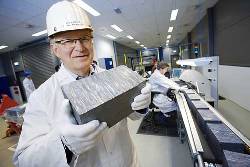Apr 15 2010
Elkem Solar, a Norwegian producer of solar-grade silicon, has combined basic and applied research to develop production methods that cut costs and consume less energy than conventional silicon production.
 Ragnar Tronstad, R&D Director of Elkem Solar
Ragnar Tronstad, R&D Director of Elkem Solar
The Kristiansand-based company has now accomplished its three primary objectives. Silicon production costs have been significantly reduced compared to conventional production. Energy consumption has been cut dramatically. All the while, its efficient methods preserve the power output of silicon-based solar cells manufactured at its facilities, compared to silicon solar cells produced by traditional means.
Teamwork: researchers and industry
“In 2000 we launched a knowledge-building project, our first with the research institute SINTEF and NTNU (the Norwegian University of Science and Technology) up in Trondheim,” recalls. “In the ten years since, we’ve carried out several such projects, and our company has been the project owner for a number of user-driven innovation projects with those same partners.”
Fruitful processes
“The knowledge-building projects provided us with key basic knowledge, explains Dr Tronstad, “and at the same time they enabled us to persuade the university to conduct research on thematic areas we found to be highly significant. In the innovation projects, we have conducted user-driven research and worked towards commercialisation.”
“Our progress has been enormous this past decade. Without the projects funded by the Research Council, we would not be where we are today.”
Vast potential
Traditional production of silicon involves first gasifying the raw material, a costly and energy-intensive method. Elkem’s method is based on traditional metallurgy; the raw material is melted and then undergoes several processing stages to prepare 10-kg silicon blocks for sale to solar cell producers. This method makes production more cost-effective and energy-efficient and is suitable for large-quantity production.
“The market potential is vast, but the financial crisis has led to major reductions in the market price for our product,” says Dr Tronstad. “To be competitive it’s essential to drive production costs down.”
Promising future
Dr Tronstad believes strongly that the international solar cell industry will continue to grow, and that all the silicon that is produced will be sold.
“We will need to increase our production volume to keep pace with the anticipated growth. The first step is raising production at our new facility in Kristiansand to its maximum output of 6,000 tonnes in the course of 2010. Once we see that the technology, the market and production follow our expectations at that site, we plan to establish a second production facility.”
Elkem and its research
Elkem makes the most of a combination of types of project funding from the Research Council. The company has received funding for innovation projects under the Programme for User-driven Research-based Innovation (BIA) – the Research Council’s open competitive arena for such projects – as well as funding for basic competence development through Knowledge-building Projects with User Involvement (KMB) under the RENERGI programme. Elkem is also a partner in the Norwegian Research Centre for Solar Cell Technology, one of Norway’s eight Centres for Environment-friendly Energy Research (FMEs).
The Research Council’s most common forms of support for industry-oriented research
User-driven Innovation Projects (BIP) represent one of the Research Council’s most important funding instruments for promoting industrial research and innovation. Industry players themselves are responsible for deciding what is to be studied, and research activities must clearly reflect the company’s own strategic targets.
Knowledge-building Projects with User Involvement (KMB) are designed to promote the development of research groups in order to boost the international competitiveness of Norwegian trade and industry. This is a key funding instrument for enhancing the ability of Norwegian private enterprise to face competition in the global market.
Source: http://www.elkem.com/eway/default.aspx?pid=242